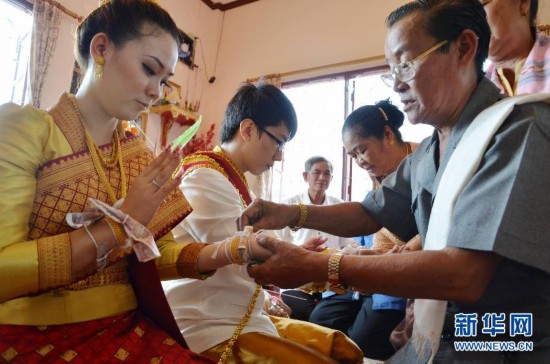

 |
| Wedding in Laos. (Photo/Xinhua) |
Language and movement, color and costume, food and drink are all inextricably linked in the beauty, ritual and celebration of love and life that a wedding represents.
From food and drink to dance and fun, one place that is no stranger to welcoming visitors from abroad to share in its merry mix of multi-ethnic riches and general bonhomie is the Southeast Asian land of Laos, a relatively small nation that sits in a large and linguistically diverse neighborhood.
While many may be be more familiar with cultural traditions of Laoslarger and better known neighbors, those fortunate enough to experience genuine Lao hospitality are most unlikely to come away feeling shortchanged.
Flanked for the most part by the meandering Mekong and a rugged Annamite range, lies this relatively diminutive yet welcoming country that is increasingly stepping into the limelight.
Despite a population numbering just six and a half million, the landlocked yet increasingly regionally land-linked nation boasts a rich linguistic and cultural diversity from top to bottom.
Here in Laos, as with elsewhere in the region, both friendships and familial connections through marriage provide the stability and social capital for personal and collective progress alike; a gift from generation to generation.
These cultural and socioeconomic facets are on show than when it comes to the celebration of nuptials, which appear to reach their peak in numbers in the cooler months of December and January when the sultry tropical heat gives way to milder temperatures of its winter that many from higher latitudes could be mistaken for spring, or, even summer.
In Laos, one can see the key role of marriage in bringing together not just the couple but also their families, friends and close connections, all together in a veritablecommunity of common destiny.
Indeed, this spirit is evidenced in the fact that so many a Lao family has welcomed a bride or groom into the fold from another ethnic group or foreign land, graciously sharing their rich traditions and culture while welcoming the addition of differing traditions with roots possibly both close and far from its own borders.
A charming mix of strong devotion to time-honored traditions in conjunction with a casual easy come-easy-go attitude, a Lao wedding is also about the business of serious fun.
Weddings are also great chances to get to know your neighbors and friends of friends, providing valuable mortar that strengthens the bonds between society's building blocks and aids the development of deeper and stronger social connections.
Foreigners are sometimes surprised to get last minute wedding invites in Laos from friends or the family of the betrothed, but such attendance is always welcomed as merit and fortune.
Laos' traditional wedding attire showcases the countrys long and rich tradition of high quality silk, with lady folk, including the bride, seen dressed in bright colors, which is a joy to behold.
The groom and his party may also be dressed in a combination of fine silk shirts and pantaloons, which while fine and impressive, have a more tailored fit than they may first appear.
A traditional wedding day in Laos is both a morning and evening affair, with a siesta-style break possible in the middle to regroup or allow guests to undertake any necessary tasks.
The wedding day morning kicks off with the groom, his family and friends promenading to the bride's house to the sound of music playing and the enjoyment of small but potent shots of local Lao or imported whiskeys.
Upon arrival, they stage a make believe battle to enter, with the bride's own ladies in waiting and assembled aunties alike putting up a feisty in slightly fictitious effort to repel the advances of the grooms party.
Once inside the brides home the centerpiece of the mornings festivities is the "baci," a tradition with roots in animist practices and strongly influenced by the Buddhist beliefs that have long prevailed among the countrys majority.
Held also for welcomes, farewells and other milestones, the "baci" sees the chanting of holy words by an elder before the placing of tied strings around the couples wrists symbolizing the best wishes and ties that bind, along with wishes for good health and prosperity.
The enjoyment of food and drink follows, with the flow of people and conversation proceeding in a way that might appear organic and unstructured to the unschooled outsider.
Such enjoyment takes its happy toll, and after a few hours the guests take temporary leave to rest, digest, or do necessary duties at home, in the office, shopfront or field.
Meanwhile, the hosts refresh themselves while preparing for the evening's festivities.
Nighttime may well see the bride and ladies in new evening finery, highlighting again the Lao silk tradition. These days, men may well be dressed in a smart evening suits with matching ties.
Some couples also opt for a further costume change in homage to the iconic white dress, the popularity of which is no longer limited to the West.
The couple welcome their guests warmly, exchanging greetings and posing for photos before a door attendant plies guests with further whiskey for shared fortune.
Visitants then proceed through an honor guard of parents and close relatives of the couple, bowing and raising their hands together in the "nop", a traditional prayer-like greeting in the region.
Once inside, typical entertainment may come in the form of a Lao band, playing the "mor lam" style so popular in the country and the Isaan region of neighboring Thailand.
The bride and groom rejoin the festivities to warm welcome and wishes of abundant good luck.
Friends old and new alike then sit down to the serious business of partaking of festive food and supping on drinks along with imparting stories of past and present, with the clinking of glasses heard on a regular occasion.
Meanwhile, the couple make their way around the venue greeting and thanking attendees each and every one, while receiving their good wishes for a happy marriage.
Before too long the dance floor draws in the couple and then attendees alike in a typical slow and graceful circular dance that contrasts the dexterity of the ladieshand movements against more knowing yet nonchalant grooves of the menfolk.
Another favorite is the Lao form of line dancing; with ages from young to old represented in clearly well-known moves that can be adapted to local and foreign tunes alike.
Participation of all is welcomed warmly and positively in the Lao tradition and any underlying stresses or strains of daily life or differences are forgotten for the evening.
Likewise, any language barriers between Lao and foreign participants are quickly traversed through sincere efforts and the help and, occasional hindrance, of liquors strong and constant flow.
Conviviality and neighborliness aplenty, along with the libations and tolerance for linguistic and cultural difference, means that a Lao wedding is something to both behold and enjoy.
After a day of memorable and warmhearted moments, guests make their own way out and by about 11:30 p.m., its time to bid fond farewells and wish sweet dreams of love ever after to all, in this early-to-bed, early-to-rise country, with good memories etched in memories forever, coupled with merry anticipation of the next Lao wedding.
 Have you ever taken these beautiful subways in China?
Have you ever taken these beautiful subways in China? Chinese beauties, foreign models meet in Chengdu
Chinese beauties, foreign models meet in Chengdu Awesome! Aerial pictures taken on J-11 fighter
Awesome! Aerial pictures taken on J-11 fighter A foreign girl explains what China should be proud of
A foreign girl explains what China should be proud of Chinese navy's air-cushioned landing craft in pictures
Chinese navy's air-cushioned landing craft in pictures Chinese pole dancing master opens class in Tianjin
Chinese pole dancing master opens class in Tianjin Splendid Sichuan after snow
Splendid Sichuan after snow College girl of Vancouver crowned Miss Chinese Int'l 2016
College girl of Vancouver crowned Miss Chinese Int'l 2016 Pentagonal Mart becomes the largest vacant building in Shanghai
Pentagonal Mart becomes the largest vacant building in Shanghai Top 20 hottest women in the world in 2014
Top 20 hottest women in the world in 2014 Top 10 hardest languages to learn
Top 10 hardest languages to learn 10 Chinese female stars with most beautiful faces
10 Chinese female stars with most beautiful faces China’s Top 10 Unique Bridges, Highways and Roads
China’s Top 10 Unique Bridges, Highways and Roads Hijacking the airwaves
Hijacking the airwaves Ma’s island visit draws line for DPP
Ma’s island visit draws line for DPP Private schools attempt to keep Tibetan language alive
Private schools attempt to keep Tibetan language alive Poor reviews spark debate about Lang Lang’s musical standing
Poor reviews spark debate about Lang Lang’s musical standingDay|Week